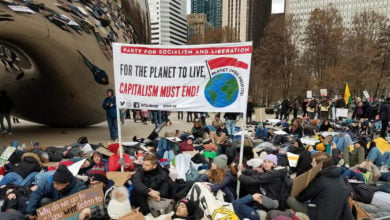A federal district court judge on May 4 overturned the Centers for Disease Control’s moratorium on evictions, scheduled to be in effect until June 30, 2021. The decision overturning the order appears overreaching and has been stayed, at least temporarily, on an appeal by the U.S. Department of Justice.
However, coming on the heels of successful challenges to the eviction moratorium in other jurisdictions, it is indicative of how landlords are licking their chops to throw millions of renters out onto the streets as soon as possible. These imminent evictions will exacerbate a disaster that was already in the making before the COVID pandemic struck.
The CDC order extending the moratorium on evictions, issued March 28, 2021, noted that as of August 2020, 30 million to 40 million renters were at risk of eviction. Over 4 million face imminent eviction due to unpaid rent when the moratorium extension was put into effect.
While the Trump and Biden rescue packages provided $45 billion in assistance for renters facing eviction. However, a study by the National Low Income Housing Coalition pointed out that as of March 2021, one-in-three renters could not find their local rental assistance program or did not know where to apply.
Tenant advocates from across the United States complain of how difficult it is to process the rental assistance. Some said filling out an application is like sending it into a black hole. In Michigan, state legislators sat on the first installment of rental assistance received in January 2021 for three months. This deprived renters of that assistance while their landlords were initiating eviction proceedings.
Sky-high rents and low wages choke millions
Even before the COVID-19 pandemic, millions of poor and working people were already facing a housing crisis. A study entitled Out of Reach, published by the NILHC in August 2020, noted that the average monthly fair-market rent for a one-bedroom rental home in the United States was $1,017 and $1,246 for a two-bedroom home.
The Department of Housing and Urban Development’s figure for a fair-market rent, including the cost of utilities, is 30% of one’s income. For a worker to afford the fair-market rent using HUD’s guideline, they would have to earn $23.96 an hour for a two-bedroom home and $19.56 an hour for a one-bedroom rental home.
The study cited above points out that an affordable rent based on the 30% threshold for an individual relying on SSI (Supplemental Security Income) would be $235 a month. For an individual making the federal minimum wage, rent would be $377 per month, and for a family of four with income at the federal poverty level, $655 per month. For a worker with a $15 per hour minimum wage, rent based on the 30% income threshold would only be $779, far less than the average monthly rent for even a one-bedroom home.
Securitization means more evictions
The eviction crisis facing millions of poor and working people is further exacerbated by the takeover of the rental housing market by large financial investors.
Approximately 11 million families lost their homes to massive number of foreclosures from 2005 to 2011. These foreclosures were a product of deliberate predatory lending practices by the banks and financial institutions, driven by the fact that the profit margin was eight times higher on securitized instruments based on subprime loans as compared to traditional fixed-rate mortgages.
The banks marketed these predatory loans particularly to African Americans and Latinos. This led to a 53% loss of net worth for African Americans and 66% loss in net worth for Latinos due to home foreclosures during those years.
When homeowners defaulted on these mortgages, the banks foreclosed on the loans. Then the banks were bailed out by the federal government while the homeowners were evicted.
Fannie Mae and Freddie Mac, nationalized by the federal government in 2008, paid the banks full value on their fraudulent unpayable loans, then took them over. The federal government would carry out the evictions of the homeowners, and then sell the homes at auction for a small fraction of what was owed.
Many of the homes auctioned off by Fannie Mae and Freddie Mac were then purchased in bulk by Wall Street investment companies. By 2016, 95% of the distressed mortgages on Fannie Mae and Freddie Mac’s books were auctioned off to Wall Street investors. These investors loaded up on foreclosed properties at a huge discount, and then made a quick killing on them as rental properties or through land contracts.
Your landlord is likely on Wall Street
By 2018, Wall Street’s real estate grab of residential home rental properties ballooned to about $60 billion, representing hundreds of thousands of properties. The largest single-family rental property holders all securitized their holdings, meaning they bundled the properties and sold them as Wall Street bond trusts. These companies included Invitation Homes, formerly a subsidiary of Blackstone, (82,570 homes), American Homes 4 Rent (51,840), Progress Residential (20,000), Main Street Renewal (17,000), Tricon American Homes (18,800) and Front Yard Residential (12,416).
Today, single-family rental homes being bought up by financial institutions is once again taking off. As individuals look for more space in their homes to set up home offices and to work remotely, the investors see the opportunity to make a killing off of rental properties. They are now outbidding young families looking to buy homes to take advantage of low interest rates, forcing them to pay inflated rents instead.
It is now estimated that one out of every five homes being sold to investors are to be used as rental properties. More than 200 companies and investment firms are in the house hunt, including computer-assisted flipper Opendoor Technologies Inc., money managers including J.P. Morgan Asset Management and BlackRock Inc. Other platforms such as Fundrise and Roofstock buy and arrange for the management of rentals on behalf of individuals, and builder LGI Homes Inc. now reports wholesale home sales to bulk buyers in its quarterly results.
The value of single-family rentals has risen by $2 trillion from 2006 to the present. As investors increasingly take over the rental market, rather than dealing with a local landlord who owns one or two houses, rents are sent to these Wall Street investment firms which own thousands of homes. All these institutions care about is how to pay off the bondholders. They have no interest in working with tenants facing difficult situations, and instead quicken a heartless eviction process.
In addition, these investors, not the small landlords who may rent a couple of properties, are the main beneficiaries of the federal rental assistance program, just as the banks and big corporations were the main beneficiaries of what were supposed to be federal programs meant to sustain small businesses. These predators do not merit one penny of funds intended to rescue the poor.
Fight to stop evictions!
Housing was already unaffordable for millions of families before the pandemic. The concentration of housing ownership in the hands of fewer and fewer corporations tied to finance capital is only serving to heighten that contradiction. We must prepare to fight back against an eviction disaster that is looming closer and closer and has already begun in many communities.
In socialist countries, housing is a human right. In Cuba, after the revolution, evictions were banned and rents set at 10% of income. By the 1990s, the homes were turned over to their occupants with no mortgages owed on them.
In the United States, most multi-family rental properties and 70% of mortgages are already owned or backed by the federal government. Single-family rentals are increasingly owned by investors, and are already being subsidized with federal “rental” assistance programs.
It is time to raise and expand the fight for housing as a human right. The moratorium should be extended as a stepping stone to a total ban on evictions and foreclosures. A movement is growing across the country demanding the cancellation of all back rents and mortgage payments. Rental and mortgage payments must be based on a real affordability scale, 10% or 20% of income. This is completely achievable and was done in the 1930s in Michigan where a five-year moratorium on foreclosures and evictions was enacted, with judges empowered to set reasonable payments based on ability to pay. What can make the difference is the determined struggle of the working class, whose collective power terrifies the big banks and their political servants in Washington.






